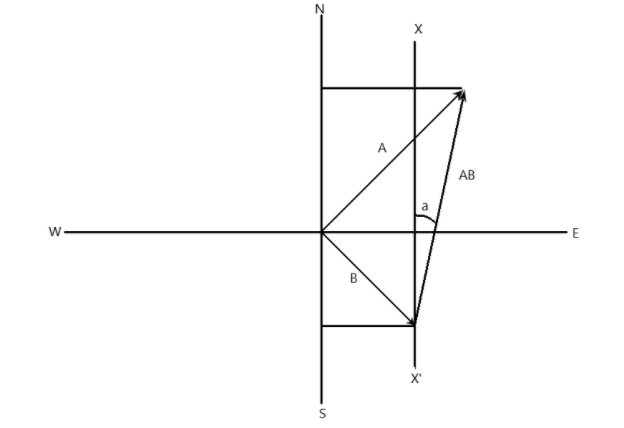Question
Question: A car A is going northeast at 80 km/h and another car B is going southeast at 60 km/h. then the dire...
A car A is going northeast at 80 km/h and another car B is going southeast at 60 km/h. then the direction of the velocity of A relative to V makes with the north an angle a such that tana is:
(A) 71
(B) 72
(C) 27
(D) 1
Solution
The velocity of car A relative to car B is graphically the arrow drawn from the tip of the arrow representing the velocity of car B to the tip of the arrow representing the velocity of car A. The angle between the direction of car A and car B is 90 degrees.
Formula used: In this solution we will be using the following formulae;
Complete Step-by-Step Solution:

To find the angle, we can draw a graphical representation of the situation stated in the question as shown above.
The velocity of A with respect to B is shown by the arrow joining the tip of the velocity of car B to the tip of velocity of car A as seen in figure. Since car A is northeast and car B is southeast, the angle between them is hence 90 degrees, and hence 45 degree angle is between them and both axes (north and east). Hence, the three vectors make up a right angled triangle.
We can see from observation, that the component of AB on the north axis is the sum of the component of B and A on the same north axis. Hence,
VABcosa=80cos45∘+60cos45∘
⇒VABcosa=8022+6022=10(42+32)
Also, the component on the east axis (horizontal) is the component of A on the horizontal minus the component of B on the horizontal, hence,
VABsina=80sin45∘−60cos45∘
⇒VABsina=8022−6022=10(42−32)
By dividing the vertical and horizontal component, we get
VABcosaVABsina=10(42−32)10(42−32)=(42+32)(42−32)
⇒tana=(42+32)(42−32)
⇒tana=722=71
Hence, the correct option is A
Note: for clarity, the angle a is the angle the velocity makes with the north axis because by mathematical principles the angle a line A makes with another line B is equal the angle the line A will make with another line C which is parallel to the line B. the line XX’ is parallel to the north axis.
